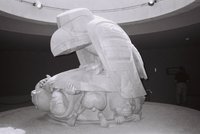Bill Reid
|
|

William Ronald (Bill) Reid (January 12, 1920 - March 13, 1998) was a Canadian jeweler, sculptor and artist. He was born to a father of European descent and a mother from the Haida (one of the First Nations of the Pacific coast) in Victoria, British Columbia. He developed a keen interest in Haida art while working as a radio announcer in Toronto, where he also studied jewelry making, having first learnt about his heritage from his maternal grandfather, who had himself been trained by Charles Edenshaw, a Haida artist of great renown.
In 1951 he returned to Vancouver and became greatly interested in the works of Edenshaw, working to understand the symbolism of his work, much of which had been lost along with the many Haida traditions. During this time he also worked on salvaging artifacts, including many intricately carved totem poles which were then moldering in abandoned village sites, and aided in the partial reconstruction of a village in the University of British Columbia Museum of Anthropology.
Working in the traditional forms and media (usually gold, silver and argillite), he began by making jewelry before branching into larger sculptures in bronze and redcedar, usually portraying figures, animals and scenes from folklore, as well as assisting in the preservation of the accompanying mythology.
Previously, children of First Nations mothers and European fathers were not eligible for Indian status in Canada. When the law was changed, Reid was quick to apply for recognition as an Indian.
His most magnificent works are two large bronze sculptures, each depicting a canoe filled with human and animal figures: one black, The Spirit of Haida Gwaii , at the Canadian Embassy in Washington, DC, in the United States and one green, The Jade Canoe, at Vancouver International Airport, in British Columbia.
He participated in the blockades of logging roads which helped save the rain forests of Gwaii Haanas (South Moresby); he also stopped work on the sculpture in Washington during this period to protest the destruction of the forests of Haida Gwaii.
Reid received many honours in his life, including honourary degrees from the University of British Columbia, the University of Toronto, the University of Victoria, the University of Western Ontario, York University, and Trent University. He received the National Aboriginal Achievement Award for Lifetime Achievement in 1994, and was made a member of the Order of British Columbia and the Order of Canada.
Having dedicated the latter part of his life to the creation of new works and these tasks of curation, Reid died in 1998, of Parkinson's disease. In July 1998, friends and relatives paddled a large cedar canoe, carved by Reid for Expo 86, on a two day journey along the Pacific coast to bring his ashes to Tanu Island in Haida Gwaii, the site of his mother's village.
His work is featured on the $20 note in the Bank of Canada's new Canadian Journey issue.
